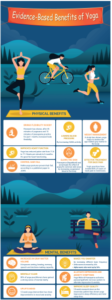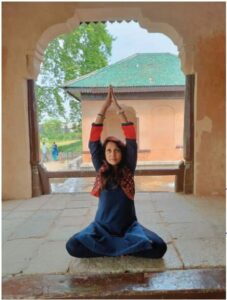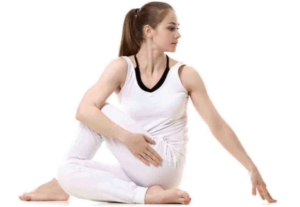Research Objectives:
The purpose of this study is to investigate the connection between Yoga and physical, mental, emotional, and spiritual health.
Keywords:
Yoga, Mental Health, Meditation, Emotional Health
Bio
Aparna More has a degree in software engineering and she is passionate International Yoga Therapist by profession. With eight years of experience, Aparna More has been living and teaching Yoga. She lives with the staunch belief that “I am enough” to make this place a better one. The purpose of her life is to spread the beauty and magic of Yoga at National and International levels. Aparna More has a Diploma in Yoga education and a teacher’s training certification from the World Yoga Alliance. She contributes her efforts into helping people towards taking their longest journey – which is the journey inwards through Yoga. Aparna More is specialised in rekindling hope in cancer survivors, people with disabilities and helping people to start loving their lives again. She does this by helping these souls to connect with themselves. Aparna More is a recipient of the Best Yoga Therapist (2022) and an Indian Icon Women personality (2019) from Western India region for her contribution in the field of Yoga.
Abstract
The rise in emotional and mental instability has become a major concern in many parts of the world, particularly after the coronavirus pandemic. Yoga has been identified as a medium through which physical and mental health challenges can be stabilized. The purpose of this study is to investigate the connection between Yoga and physical, mental, emotional, and spiritual health.
Yoga can be perceived as a combination of therapy, meditation, and exercise, connecting the self to overcome limitations linked to conditional thinking. It is a life science covering aspects of human life, relating the human body with the mind. It endeavors to establish a pathway for positive progression whilst maintaining the natural relaxed state of the body.
Upon physically performing the yoga positions or asanas there are numerous benefits including increasing serotonin levels and boosting mental clarity. Bending forward inculcates surrendering activity, in contrast bending backwards opens the heart facilitating suppressed emotions to be cleared. In addition, pranayama reduces the rate of respiration and the heart rate, thus assisting individuals to reach mental stability. Internal cleansing techniques aids individuals to release stored emotions to make space for love & compassion within oneself.
This study has found that there is a strong correlation between Yoga, mental and emotional health. Yoga creates bespoke impressions over the mind and body, to awaken the infinite potential within the self. Further quantitative studies are recommended to establish a causal relationship and develop preventive measures going forward.
YOGA – A way of life
YOGA is a Holistic regimen…there is this belief that Yoga is mostly a therapy, so people are generally looking for specific asana or postures for ailments. It surely is a great tool to fight the physical ailments, however, we need to understand that Yoga is not about symptomatic, localized treatment – the idea is to adopt Yoga holistically, to remove the imbalances in the body, the mind and the Prana, in fact this approach leads to better and more effective healing.
Yoga is a science and firstly it reflects on the outermost aspect – the physical body which most of the people cab related to. When there is imbalance on the physical aspect, all the internal organs are affected, and it starts reflecting on the self in the form of various diseases. The beauty of Yoga is that it gets the various body activities into ideal direction that assists the entire body to operate in harmony. Along with the physical aspect, emotional and mental purification is one of the yoga’s most significant attainment.
The approach is simple – If the mind is not healthy and uncontrolled, it reflects the same on the body. We are excited in the situation of pleasure and we become sad when it is a negative situation. Every thought in the mind affects the brain, nervous system and all other organs in the body. Yoga is to maintain equilibrium of the mind in any situation. This equanimity of mind is the ultimate objective of yoga – Awakening of self is yoga. Yoga is about self-inquiry and growth
The human body is made up of 5 basic elements of nature – water, air, fire, earth, ether. They represent the physical and energetic qualities of the human body and of the physical world. The ebb and flow of these five elements influence our physical, mental and emotional wellbeing. When they are in harmony, we experience peace and good health. When they are out of balance, we can experience suffering and unhappiness. The awareness and understanding of these laws of nature allows us to bring them into a state of equilibrium through Yoga and meditation practices. Yoga compliments the presence of these elements and hence taps into the curative power the body possesses to naturally heal itself. Yoga is an antidote for all the health issues in the life. Every little or long deep breath you take is a healing pill that you give your mind and body
This is true especially post the Pandemic wherein the focus has shifted on emotional and mental wellbeing which is then reflected on your physical health. As Yoga is a therapy session, a work-in – mind it I am saying it’s a work in – as it is a therapy, meditation and physical postures all at the same time, this helps you in taking your longest journey which is the journey inwards.
There is a stance of Yoga practice that it works towards illness impediment thus stimulating and enhancing the quality of life by boosting the health. The practice of Yoga is blossoming and growing faster across the globe. In present era, Yoga is one of the most eminent and notable well-being application. It is a wide and eclectic application that encompasses each and every aspect of life. It is actually a way of living.
YOGA – A Science
Yoga is a science, that is, it is a framework of approach that directs us to intentionally link not only with the self but also with our lives. As Yoga is a science, there is no ethic or ideology linked to it. Like in scientific experiments, we have few procedures to follow and that would yield the result similarly Yoga guides us to do definite action and then to feel and sense the impact of that action, for example – if we breath in a relaxed manner the heart rate goes down and normalizes; if we focus on our breath, the thoughts slowly start reducing and we become calm and composed. Yoga is a complete package bundled in one – breath control, mindfulness, physical activity and mindfulness. It is also a spiritual practice attempting to link the individual awareness to the entire Cosmos making us understand that we are part of this Universe and not separate from it.
The scientific nature of Yoga was unveiled when Swami Kuvalayananda administered scientific experiments in Yoga in 1924. The organization Kaivalyadham Institute for scientific research on Yoga was established in Lonavala, Pune – India. The research findings eradicated several yoga misconceptions and unraveled the mystical sheath dealing with it. The principles of Yoga were related in biological terms – encompassing the anatomy and physiology aspect. The study this way aids in comprehension of the yogic mechanism and their application for the patient in detailed way. Once the basic structure and various functions of the body are known, it becomes easy to apply, understand the mechanism of the yogic practices as well as the effects of the same on the psychological aspect of the human body. Also, when the concepts are clear, it becomes easy to modify the techniques which can suit an individual. Tailoring of the asanas and the breathing practices becomes easier with it.
Once the results were visible, the popularity of yoga increased and many started becoming aware of the benefits. Numerous doctors and health specialists started recommending yoga as a wholistic approach not only to treat injuries and illness but also as an substitute to surgery in the cases that it can be applied.
Yoga practice is a well-researched ability to make positive long-term changes to not just the body but our brains too. Yoga is an inmost science incorporating numerous techniques to attain the unification of the body and mind to attain self-knowledge which when one has gives an individual the strength to deal with others.
The Indian Prime Minister (Mr. Narendra Modi) launched a YOGA DAY on 21st June which has been observed by United Nations General Assembly. Assigning a day for Yoga signifies the importance of Yoga that has been experienced by innumerable people and the way it is helping holistically. This day is celebrated in more than 170 countries like UK, Canada, China, USA etc. There are various Yoga activities that are planned throughout the day that not only enhances the Yoga awareness but also guides people on how and where to get started. The public has realized how Yoga increases the level of wellbeing and helps to make subtle but profound changes in the life styles of the people in a positive way.
Yoga develops positive attitude and promotes positive health. As an amalgamation of art and science, it provides entire human force with eye and mind to understand not only the human mind but also the various facets of the prevalence.
1.2. Management of lifestyle diseases and Psychosomatic disorders through Yoga
Succeeding the Pandemic and Covid, there has been manifold increase in the anxiety levels, stress, depression and psychological distress. The numbers are below:
Anxiety: 6.33% to 50.9%
Stress: 8.1% to 81.9%
Depression: 14.6% to 48.3%
Psychological distress: 34.43% to 38%
Yoga has been instrumental in working on the emotional and mental level and has got a definite potential to heal the people suffering from lifestyle disorders and stress that leads to further array of diseases and this is because Yoga extends both physical and mental health benefits for humanity across the ages.
Recent studies positively depict the outcome of Yoga and meditation on overall human healthiness on the various below areas:
- Endocrine disorders – Thyroid, Hormonal imbalance
- Psychological diseases – Mental stress, anxiety etc.
- Endocrine irregularity – Thyroid, hormonal imbalance etc.
- Neurological ailments – Alzheimer’s disease etc.
Certain breathing practices like Kapalbhati, Anuloma Villoma, Bhramari or Pranayama are the best remedies to tackle respiratory issues (Behera M, Priyadarsini N, Mohapatra D, et al, 2015).
Yoga has helped in various disorders like post-traumatic stress and other stress related diseases (Wynn, 2015). Yoga approach is highly potent to diminishing mindfulness-based stress in patients that are fatigued due to cancer and its related symptom (Johns, Brown, BeckCoon et al. 2015). Yoga is literally a behavioural practice strengthening not only the physical aspect but also the breath and mindfulness thus assisting the psychological and biological adaptations in human population (Birde, Sohl, Wallston, 2016). Yoga has been instrumental for treating modern diseases like stress, obesity, diabetes, hypertension by increasing the p a r a s y m p a t h e t i c activity and reducing sympathetic activity (Cramer, 2015). There are reports that revealed yoga works directly on most important detox organs (pancreas, liver, kidney) to maintain the insulin resistance thus working on controlling Diabetes (Chandrasekhar, 2009). More scientific evidence is required to talk about the curative role of Yoga on Cancer, however, techniques like Yoga Nidra and some asanas along with breathing techniques are helpful in disruption of sleep cycle and fear within the patients of cancer (Smith, Pukall, 2009).
It is completely legal and right to say and also numerous studies have shown that Yoga is a complimentary healing for the majority of the serious illnesses.
Due to its positive impact on both mental and physical health, yoga and meditation are becoming more and more popular.
The practice of yoga allows us to fully manifest our innate potentiality, making it appropriate to refer to it as the science of infinite human possibilities. Yoga addresses every facet of the philosophy, psychology, and application of conscious evolution at once. Rather than just giving the theorems or the concepts, it actually acts as an instrument providing the required direction to feel and sense this magnanimity

YOGA – Beyond Physical Aspect
Yoga is not mere about physical postures, but what and who you are and what intention you set while performing these postures works on freeing the consciousness from the limitations of the conditional thinking. This awakens the infinite potential within oneself and connects one to the self which is the highest state of the BLISS. Studies depicted that the yoga class begins with a primary aim of physical fitness, but as the class progresses, they notice that it not only removes the clutter off the mind it also quietens the mind thus exposing us to the Universal language of silence. Once you get to thus state the change is reflected far away from physical arena and focused more on mental and emotional aspects. This is the phase of self actualization.

I have had many students who started practicing Yoga for physical treatment, but as they become more involved, practicing with awareness, the experience of the holistic impact on the entire body and the mind got them to embrace the Yogic science for reasons far beyond the physical therapy.
We cannot scrub our inner bodies – we need to learn the skills that cleanse our tissues, organs and mind and that is YOGA.
The various basic asanas dive much deeper than the physical aspect. Let us see how it does that:
Stretching asanas
Stretching increases joint range of motion, enhances blood flow, improves posture, and relieves muscular tension all over the body. The mental and emotional benefits that we gain from this are:
2.1.1 Stretching does not only opens up the physical body and the muscles, but increasing the serotonin levels that reduces stress which in turn creates mental clarity & self-esteem efficiently.
2.1.2 Everyone experiences stress to some degree causing muscles to become tense, once tense it tightens up and then resulting into discomfort and persistent pain. Stretching eases muscle tension, breaking the vicious cycle of pain and tension.
2.1.3 Due to opening of the upper body the clogged-up lungs are open easing the breathing process and making it deeper.
2.1.4 Two feel good hormones – Endorphins and Serotonin are released by our bodies when we stretch. Serotonin levels lower stress, which effectively improves self-esteem & mental clarity and Endorphins are in charge of activating the brain receptors that heighten pleasant emotions and lessen pain

2.2 Forward Bends asanas
The bends not only works on strengthening the spine, the legs but also stimulating the liver & the kidneys. The mental and emotional benefits that we gain from this are:
2.2.1 It inculcates the feeling of calmness as the space is created between the vertebrae in the spine which is the channel between your brain and rest of the body.
2.2.2 It is also a mean of surrendering to the Divine – so in situations that are not in our control we surrender with these bends.
2.2.3 Forward bends guides us to enjoy the journey as we move forward to touch the toes or just move in forward folds. It inculcates the feeling of being patient. A new job, a new relationship, a major move, or anything else that forces us outside of our comfort zone can occasionally feel uncomfortable at first but turn out to be the best decisions we could have made once we patiently move through it. Likewise, if we bend forward with a mind free from all negativity and we can start to let go of discomfort, impatience and fear as the heart is full of gratitude.

2.3 Backward Bends asanas
Apart from a nice stretch to the back, it opens our chest, shoulder muscles especially in this era wherein our necks are constantly dangling in forward movement with the cells in our hand. Also, as the lungs fully expand, it helps in taking more oxygen and we start feeling more energized. Below benefits are reaped other than physical ones:
2.3.1 The bends open the lungs, lift the heart and deepens the breath and when all these happens it gives is the courage to overcome our fears not only on the mat but also off the mat.
2.3.2 As the heart opens up, any suppressed emotions, unresolved trauma starts melting.
2.3.3 Backbends increase the body’s energy levels and release mood elevating hormones into the blood stream. At an emotional level, as the body arches up, the mind also does the same, making room in our lives for new emotions, experiences and feelings. It is a physical vulnerability that gives us the courage to become more receptive in our personal relationships as well as other areas of life.

2.4 Twisting asanas
By bolstering our spinal structure, these asanas enable us to become more flexible. By causing intraabdominal compression, it promotes the digestive system’s optimal operation. On releasing the twist, the digestive organs receive new blood that is nutrient-rich and oxygenated. Along with the most important detox organs like liver, pancreas and kidneys, spleen, liver and gall bladder are stimulated. Apart from physical benefits, below things are achieved:
2.4.1 It activates the most important detox organ – liver in the body, which helps in insulin release and balancing the sugar in the body.
2.4.2 Apart from making us physically flexible it also prepares us emotionally & mentally to handle any situations in our lives as our spine is a recorder, recording all the emotions. With the twists we shed all these unwanted feelings.
2.4.3 Although the human body is designed for diverse dynamic activities, if we do not remain conscious to maintain it at optimum level, it builds up stress and the body piles up with the impurities. A clean and health body would have an upsurge of energy that can be consumed to work on any disease or discomfort. The Yoga twists works on quietening the chattering minds by reducing the anxiousness and stress. The practitioner stays in the present moments building more positive approach.

2.5 Balancing asanas
While doing the balancing asanas, the gravitational center of our bodies is in line with the gravitational field of the planet. Balancing requires one’s constant attention as well as a steady mind. Regularly doing these asanas enhances the mental stability and concentration. It strengthens the entire lower body and the nervous system. The mental and emotional benefits are as below:
2.5.1 The cerebellum, the part of the brain that regulates how the body moves, is trained in all balancing asanas.
2.5.2 All the balancing asanas requires the entire set of the muscles in the body to collaborate. The nervous system and the brain coordinates for the same. These asanas enhance the posture and muscle coordination while bringing about physical and nervous balance and stopping unintentional movement.
2.5.3 The concentration needed to perform the asanas steadily cultivates balance and concentration on the emotional, mental, and psychic levels, reducing stress and anxiety.
2.5.4 It not only balances your body but also your emotions at all the levels – emotional, mental and psychic levels, and once the emotions are balanced, we gain control on our day to day lives. It also induces the feeling of being rooted and being strong irrespective of the outer conditions.
We see Yoga is the gateway to better spiritual and emotional health apart from being just physical. But we need to execute these postures with awareness and complete intention with the presence of the breath to experience these deep benefits.
Conclusion
Your body is speaking to you every moment of your life through the various sensations. The question is are you really that aware that you listen to it? Adopt Yoga to know yourself, to be aware of yourself and be mindful. Once this is done, your relationship with the self changes and this brings in great positive change in your relationships with others.
Yoga is a drugless therapy. Adopt it to bring peace, stability and satisfaction physically, relaxation and harmony in body-mind functions and positivity in all the relationships. It also has a preventive aspect that can be of great help to one and all to promote and maintain fitness, health and happiness throughout the life by guarding us against stress and strain.
The original, ageless science of the Self is Yoga – it is an essential practice for the soul, working through the medium of our body. It is all about self-inquiry and growth, it is not just looking good but feeling good. ACKNOWLEDGEMENTS This endeavor would not have been possible without the support of my Parents, Daughter, Husband and my in-laws. Gratitude to my students who trust in me and gives me an opportunity to share beauty and magic of Yoga with them. They are the ones who gives me DOSE – Dopamine, Oxytocin, Serotonin, Endorphins in my everyday sessions.
Acknowledgements
This endeavor would not have been possible without the support of my Parents, Daughter, Husband and my in-laws. Gratitude to my students who trust in me and gives me an opportunity to share beauty and magic of Yoga with them. They are the ones who gives me DOSE – Dopamine, Oxytocin, Serotonin, Endorphins in my everyday sessions.
References
Behera M, Priyadarsini N, Mohapatra D, et al. Alleviating Respiratory Diseases by Alternative Method– Yoga. Int J Pharm Sci Rev Res. 2015; 32: 250–253p. Art. No. 41.
Wynn GH. Complementary and Alternative Medicine Approaches in the Treatment of PTSD. Curr Psychiatry Rep. 2015; 17. Art. No. 62.
Johns SA, Brown LF, Beck-Coon K, et al. Randomized Controlled Pilot Study of Mindfulness-Based Stress Reduction for Persistently Fatigued Cancer Survivors. Psycho-Oncology. 2015; 24: 885–893p.
Birdee GS, Sohl SJ, Wallston K. Development and Psychometric Properties of the Yoga Self-Efficacy Scale (YSES). BMC Complement Altern Med. 2016; 16. Art. No. 3.
Cramer H. The Efficacy and Safety of Yoga in Managing Hypertension. Experimental and Clinical Endocrinology and Diabetes. In Press; 2015. doi: 10.1055/s-0035- 1565062.
Chandrasekhar R. Can Yoga Cure Diabetes? Health Administrator. 2009; 22: 40–41p.
Smith KB, Pukall CF. An EvidenceBased Review of Yoga as a Complementary Intervention for Patients with Cancer. PsychoOncology. 2009; 18: 465–475p.
Will Yoga help with WEIGHT LOSS? My answer – May be, but it will surely help you lose weight of your insecurities. It is about feeling good rather than looking good. If you ask 10 people who do Yoga as to what is Yoga you will have ten different answers as everyone has their own experience while in yoga.
M.M.Gore, 1984, Anatomy and Physiology of Yogic practices, New Age Books, New Delhi, India
Denise Rankin-Box (June 2015). Yoga being a science and not just an art Available: The science of yoga — what research reveals (elsevier.com)
FITSRI Yoga Benefits & Statistics Infographic. Page 5 Available: https://www.fitsri.com/ articles/yoga-benefits-statisticsinfographic
Deepak Semwal, Ashutosh Chauhan, Satyendra Mishra, Ruchi Semwal, May 2016, Yoga, Recent development in Yoga – A Scientific Perspective. Mumbai, India, Pages 3-4 (PDF) Recent Development in Yoga: A Scientific Perspective (researchgate. net)
Ananda Balayogi Bhavanani, January 2011, Understanding the Science of Yoga. Mumbai, India, Pages 3-4 (PDF) Understanding the Science of Yoga (researchgate.net)


